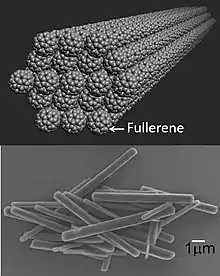Fullerene whiskers
Fullerene whiskers are thin rods composed of fullerene molecules, such as C60, C70, or their mixtures. Hollow fullerene whiskers are called fullerene tubes. Such structures typically have a diameter of a few micrometers. When the diameter becomes smaller than 1 micron, the corresponding structures are called fullerene nanowhiskers or fullerene nanotubes.[1]

Fullerene whiskers and tubes are held together by weak van der Waals forces, and hence are very soft.[1] They can be grown by precipitation at an interface between two liquids. They are semiconductors and have potential uses in field-effect transistors, solar cells, chemical sensors, and photocatalysts. When doped with alkali metals, such as potassium, they become superconductors.[2]
As-grown fullerene nanotubes have hexagonal shapes and face-centered cubic crystal structures. Owing to their relatively large inner diameters (ca. 100 nm) and low reactivity they can accommodate a wide range of nanoparticles. C60 nanotubes decompose upon heating to 416 °C (781 °F) in air.[1]